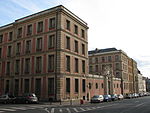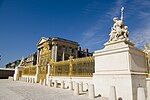Recollects Convent (Versailles)
Franciscan churches in FranceFranciscan monasteries in FranceFrench RevolutionLouis XIVVersailles

The Recollects Convent was built originally in 1684 at the Palace of Versailles, France by order of Louis XIV as a house for the religious order of Recollects - a reform branch of the Franciscans created in 16th century in France, Germany, and Holland. After the order was suppressed during the French Revolution, the building was converted into a prison, and then later in the 19th century was used by the French army. Currently occupied by the French Ministry of Defense, the convent is only open to visitors during certain public events, such as Le Mois Molière (an annual theater event organized by the city of Versailles).
Excerpt from the Wikipedia article Recollects Convent (Versailles) (License: CC BY-SA 3.0, Authors, Images).Recollects Convent (Versailles)
Rue des Récollets, Versailles
Geographical coordinates (GPS) Address Nearby Places Show on map
Geographical coordinates (GPS)
| Latitude | Longitude |
|---|---|
| N 48.8025 ° | E 2.1225 ° |
Address
Service Technique des Bâtiments Fortifications et Travaux (STBFT)
Rue des Récollets
78000 Versailles, Saint-Louis
Ile-de-France, France
Open on Google Maps











